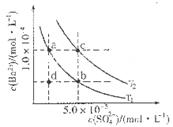下表是几种弱电解质的电离平衡常数、难溶电解质的溶度积Ksp(25℃)。
| 电解质 | 电离方程式 | 电离常数K | Ksp |
| H2CO3 | H2CO3 HCO3-+H+ HCO3-+H+HCO3- | K1=4.31×10-7 K2=5.61×10-11 | - |
| C6H5OH | C6H5OH C6H5O-+H+ C6H5O-+H+ | 1.1×10-10 | - |
| H3PO4 | H3PO4 H2PO4-+H+ H2PO4-+H+H2PO4- HPO42- | K1=7.52×10-3 K2=6.23×10-6 K1=2.20×10-13 | - |
| NH3·H2O | NH3·H2O OH-+NH4+ OH-+NH4+ | 1.76×10-5 | - |
| BaSO4 | BaSO4(s) Ba2++SO42- Ba2++SO42- | - | 1.07×10-10 |
(1)写出C6H5OH与Na3PO4反应的离子方程式:_________________。
(2)25℃时,向10 mL 0. 01 mol/LC6H5OH溶液中滴加V mL 0.1 mol/L氨水,混合溶液中粒子浓度关系正确的是__________(填序号)。
a.若混合液pH>7,则V≥10
b.V=5时,2c(NH3·H2O)+2c(NH4+)=c(C6H5OH)+c(C6H5O-)
c.V=10时,混合液中水的电离程度小于0.01 mol C6H5OH溶液中水的电离程度
C6H5OH溶液中水的电离程度
d.若混合液pH<7,则c(NH4+)>c(C6H5O-)>c(H+)>c(OH-)
(3)水解反应的化学平衡常数称为水解常数(用Kb表示),类比化学平衡常数的定义。25℃时,Na2CO3第一步水解反应的水解常数Kb=____mol/L。
(4)如图所示,有T1、T2不同温度下两条BaSO4在水中的沉淀溶解平衡曲线(已知BaSO4的Ksp随温度升高而增大)。

①T2____ 25℃(填“>”、“<”或“=”);
②讨论T1温度时BaSO4的沉淀溶解平衡曲线,下列说法正确的是____(填序号)。
a.加入Na2SO4不能使溶液由a点变为b点
b.在T1曲线上方区域(不含曲线)任意一点时,均有BaSO4沉淀生成
c.蒸发溶剂可能使溶液由d点变为曲线上a、b之间的某一点(不含a、b)
d.升温可使溶液由b点变为d点
(1)C6H5OH+PO33-=C6H5O-+HPO42-(2分) (2)b(2分) (3)1.78×10-4(2分)
(4)①>(2分) ②bc(全对得2分,只选一个且正确得1分,多选或错选的0分)
题目分析:(1)弱酸的电离常数越大,酸性越强。根据电离平衡常数可知,苯酚的电离常数小于磷酸的第一步和第二步电离平衡常数,而大于磷酸的第三部电离平衡常数,所以依据较强酸制备较弱酸的原理可知C6H5OH与Na3PO4反应的离子方程式为C6H5OH+PO33-=C6H5O-+HPO42-。
(2)氨水的电离平衡常数大于苯酚的电离常数,所以C6H5O-的水解程度大于NH4+的水解程度。V=10时,二者恰好反应生成苯酚铵。由于C6H5O-的水解程度大于NH4+的水解程度,因此溶液显碱性。a、若混合液pH>7,则V不一定等于等于≥10,a不正确;b、V=5时,苯酚过量,所得溶液是苯酚铵和苯酚的混合液,且二者的浓度相等。所以根据物料守恒可知2c(NH3·H2O)+2c(NH4+)=c(C6H5OH)+c(C6H5O-),b正确;c、V=10时,二者恰好反应生成苯酚铵。由于C6H5O-的水解程度大于NH4+的水解程度,因此溶液显碱性。苯酚能电离出氢离子,抑制水的电离,所以混合液中水的电离程度大于0.01mol/LC6H5OH溶液中水的电离程度,c正确;d、若混合液pH<7,则苯酚一定是过量的,所以溶液中离子浓度大小顺序是c(C6H5O-)>c(NH4+)>c(H+)>c(OH-)或c(C6H5O-)>c(H+)>c(NH4+)>c(OH-),d不正确,答案选b。
(3)水解反应的化学平衡常数称为水解常数(用Kb表示),类比化学平衡常数的定义。25℃时,Na2CO3第一步水解反应的水解常数Kb= =
= =
= =
= =1.78×10-4。
=1.78×10-4。
(4)①根据图像可知c点表示平衡点,此时溶度积常数=1.0×10-4×5.0×10-5=5.0×10-9>1.07×10-10。由于BaSO4的Ksp随温度升高而增大,所以温度T2>25℃。
②a.加入Na2SO4增大溶液中的SO42-浓度,可以使不溶液由a点变为b点,a不正确;b.在T1曲线上方区域(不含曲线)任意一点时,溶液中c(Ba2+)·c(SO42-)均大于T1温度下的溶度积常数,所以有BaSO4沉淀生成,b正确;c.d在曲线的下方,蒸发溶剂溶液中c(Ba2+)、c(SO42-)均增大,因此可能使溶液由d点变为曲线上a、b之间的某一点(不含a、b),c不正确;d.BaSO4的Ksp随温度升高而增大,所以升温不可能使溶液由b点变为d点,d不正确,bc。
